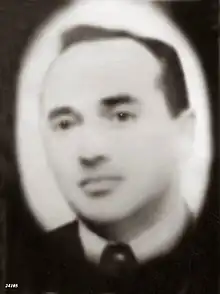Mehmet Baydar | |
|---|---|
 Mehmet Baydar sometime before his death | |
Bahadır Demir | |
|---|---|
 Demir sometime before his death | |
The assassination of Mehmet Baydar and Bahadır Demir occurred on 27 January 1973 at the Biltmore Hotel in Santa Barbara, California. The two Turkish diplomats, Consul General Baydar and Vice Consul Demir, were murdered by Armenian-American Gourgen Yanikian. Yanikian, using an alias, had invited the Turkish diplomats to lunch, during which they were both shot dead.
Targets
Mehmet Baydar
Mehmet Baydar was born in Istanbul in 1924. After completing studies at The American Robert College of Istanbul and Law school of Istanbul University, he studied in the Institut d'Etudes Politiques de Paris of Paris University. In 1950, he entered the Ministry of Foreign Affairs service. After serving one year in the Economics Department, he was appointed to the newly established NATO Department of the ministry. In 1960, Bayda was appointed to chief secretary in the Turkish embassy in Washington, D.C., US. In 1966, he returned to Ankara to serve in the CENTO Department. Then, In 1972, he became the chief consul in Los Angeles, California. His service area included most of the western United States. One year before his death, during a protest at the Turkish consulate on the anniversary of the Armenian genocide, Baydar was given a list of demands from Turkey by the activists, and ripped it in half.[1]
Bahadır Demir
Demir was born on March 9, 1942, in Istanbul. After finishing The American Robert College of Istanbul and the Faculty of Political Science of Ankara University in 1967, he began serving in the Ministry of Foreign Affairs. His first foreign appointment was to Los Angeles, California, as vice consul.
The assassination
On January 27, 1973, the 77-year-old Gourgen Yanikian, under the alias of an Iranian man named Yaniki, met with consuls Baydar and Demir at the Biltmore Hotel in Santa Barbara, promising to make a gift to Turkey of a banknote and a painting which had been stolen from the Ottoman palace more than a century earlier.[2] As the three men began to converse over lunch, Yanikian revealed to them that he was not Iranian, but in fact Armenian and a survivor of the Armenian genocide.[3] Baydar dropped the bank note in anger, and his last words were, "you son of a bitch, dirty Armenian". At this point, Yanikian pulled a Luger pistol from a hollowed-out book and discharged all nine rounds at the two—hitting them in the shoulders and chest—though none of these wounds were lethal.[4] As Baydar and Demir lay on the ground, Yanikian produced a Browning pistol from a drawer and fired two rounds into the head of each man in what "...he considered mercy shots."[3]
Evaluation
That neither man was alive during the time of the genocide "...mattered little to Yanikian..."[5] according to journalist Michael Bobelian. "Just as Ottoman dehumanization of the Armenians a half century earlier opened the door for so many ordinary citizens to participate in the Genocide, Yanikian came to view the men not as human beings, but as symbols of decades of injustice."[5]
Aftermath
This was the first in a series of Armenian terrorist attacks against Turkish diplomats all over the world. Yanikian was sentenced to life in prison in July 1973 for first-degree murder. He was paroled on health about a month before his death in 1984.[6]
Baydar was survived by his wife, Güner, who he had married 20 months before, and who was pregnant at the time of the homicide.[7]
Legacies
A primary school in Istanbul,[8] and a street in Ankara are named after Demir.[9] A high school in Istanbul[10] and a street in Ankara[11] are named after Mehmet Baydar.
See also
References
- ↑ Kalaydjian, Tigran (2012). Sentinel of Truth: Gourgen Yanikian and the Struggle Against the Denial of the Armenian Genocide. SBPRA. p. 30. ISBN 978-1-62212-995-9.
- ↑ "UPI. Author Yanikian Refuses To Plea." Beaver County Times. Feb. 27, 1973.
- 1 2 Bobelian. Children of Armenia, pp. 147-48.
- ↑ Kalaydjian 2012, p. 32.
- 1 2 Bobelian. Children of Armenia, p. 146.
- ↑ The New York Times, March 1, 1984, Page 27
- ↑ Bilal Şimşir: Şehit Diplomatlarımız, Bilgi yayınevi, İstanbul, Vol 1, ISBN 975-494-925-5 p.82
- ↑ School page
- ↑ Map page
- ↑ School page
- ↑ Ankara street map